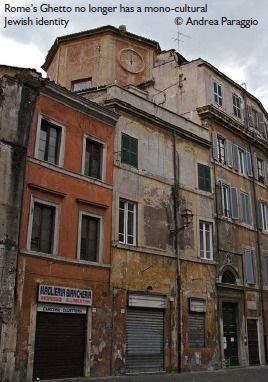Recently, a sizeable gathering assembled in Edinburgh to hear leading urban sociologist Loci Wacquant dissect the idea of the ghetto. At the heart of Wacquant’s celebrated Urban Outcasts study lies the question: ‘When is the ghetto not the ghetto?’
His main point is that the classical idea of the ghetto has given way lately to a more insidious conceptualisation.

Rome’s Ghetto no longer has a mono-cultural
Jewish identity
The classical Jewish ghetto was a communal, ethnically homogenous enclave, spatially separate but functionally integrated into the economic and commercial life of the city. By the midtwentieth century, the ghetto began to metamorphose into what Wacquant calls ‘the anti-ghetto’ on the European side and ‘the hyperghetto’ on the American side.
Hyper-ghetto in the US refers to the social implosion that followed welfare withdrawal and urban abandonment in the wake of the 1960s black ghetto riots. Anti-ghettoes in Europe stand at the opposite pole from the classical ghetto because they are not ethnically homogeneous, and so lack a unifying cultural identity. Dominant ideas about homogenous, mono-cultural ghettoes fly in the face of the reality of ethnic mixing in the most deprived parts of European cities. Today, the word ‘ghetto’ is indiscriminately appended to those peripheral areas that have experienced decades of industrial restructuring, endemic unemployment, physical deterioration and criminality.
Containing outcasts
What Wacquant calls ‘advanced marginality’ is supplanting the classical ghetto. Urban poverty and stigmatisation have become permanent rather than transitional or cyclical conditions for the urban poor.
Where the classical ghetto was an economically productive space, as well as culturally and civically vibrant – think of the Harlem Renaissance or the dense web of self-servicing ghetto institutions – advanced marginality holds out a future of economic exclusion, a civic vacuum and political irrelevance. Containing the urban outcasts in a defined place is now the main function of the penal state allied to regulation by the welfare system.
Dispelling misconceptions By studying stigmatised urban areas in a methodical and conceptually precise way, Wacquant hopes to dispel the unfounded misconceptions about the relegated places of America and Europe.
Ignorance about the specific relationship between class, race and space allows the lumpy concept of ‘the ghetto’ to be mobilised in the most cavalier fashion by politicians, academics and journalists. Moral crusades over the uncontrollable ‘ghetto’ are launched upon oceans of ignorance about the structural dynamics and lived realities of urban marginality.
British cities have always had stigmatised areas and atrocious slum conditions. These were typically places where the productive working poor were stored. But, more recently, politicians and academics who take responsibility for managing, or at least controlling, surplus populations have also imported into their lexicon the language of social exclusion, anti-social behaviour, and personalisation.
The current focus on ‘the big society’ as a remedy for ethnic and cultural segregation turns attention away from the structural realities of the emerging regime of urban marginality in the UK.
